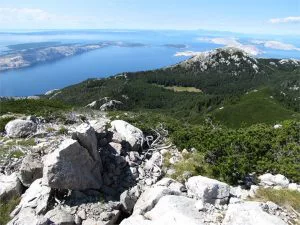Whitish gray rocks and pointy peaks, carpeted by green velvety forest lands and tall pine trees – that’s Northern Velebit National Park Croatia from an aerial view.
During the winter, these peaks become snow-capped.
And when you get up close, standing on the ground and looking up at these massive wonders, you will finally confirm to yourself why Croatia is considered as a natural paradise.
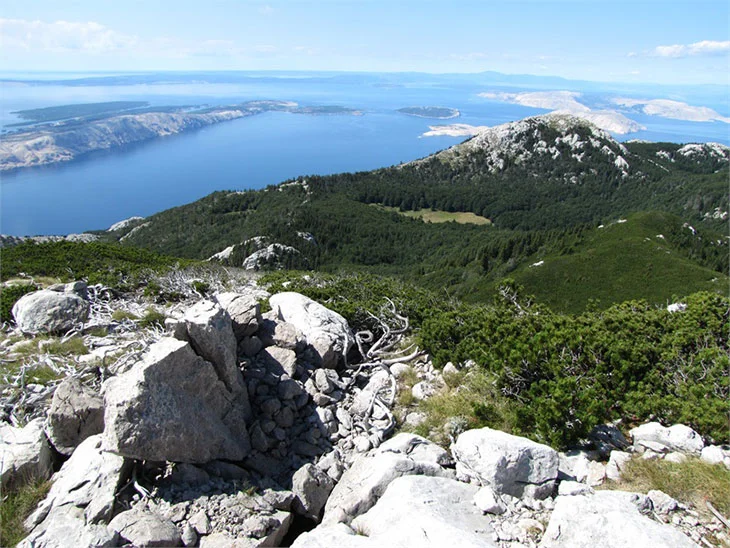
Among all the 8 major national parks in Croatia, Northern Velebit National Park is the most recent but it certainly is not the last when it comes to breathtaking views and fun activities.
And just like all national parks in the country the Northern Velebit also boasts of a spectacular wildlife.
Perhaps, the most unique thing about this park compared to all the others is that it is the most suitable for those who are not really a fan of summer nature tripping.
It is the one park that you can enjoy even in the cold winter days because you will see the mountains transform into giant white-tipped chocolate kisses.
Skiing and other winter activities are also popular in Risnjak National Park but when it comes to winter destinations in Croatia, the Northern Velebit National Park ranks higher.
Table of Contents
But of course, visiting the park during the usual spring and summer times is just as amazing.
It’s just a great thing that the park doesn’t lose its brilliance during the winter time.
Where Is Northern Velebit National Park ?
Northern Velebit National Park is situated in the largest mountain in Croatia, the Velebit range.
This vast mountain range covers about 2,000 square kilometers and stretches to over 100 kilometers from Senj to Zadar.
One other national park, the Paklenica National Park is also within this range.
But there is something utterly unique about Northern Velebit National Park Croatia despite being in a relatively similar location.
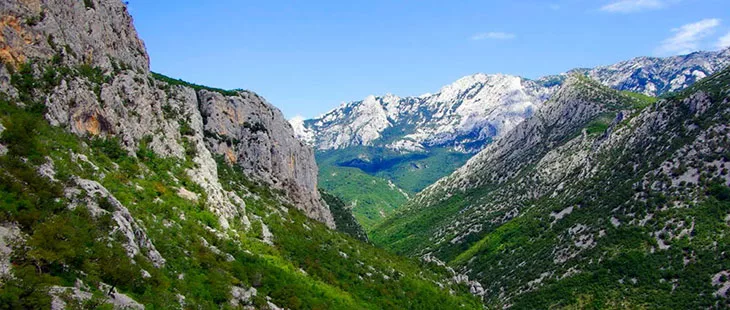
Northern Velebit National Park is in a more remote region and is less visited than Paklenica and other national parks.
It was only declared a national park in 1999 and most tourist developments around the park is relatively new. But it offers no less than stunning views and amazing outdoor experiences.
Through the coastline of Croatia, this region is where you will truly experience the Croatian outdoors since this part draws you further inland.
It is one of the most dramatic scenes in the country and is a nature lover’s paradise.
Going inside Northern Velebit National Park is like going inside a painting, with trees, mountains, and streams perfectly drawn in lively colors.
Its highland ridges offer some of the best preserved natural wilderness in southeast Europe.
It has been officially granted a protected status since it has been declared a national park.
The park also serves as a great starting point for hikers of the Premuzic Trail which offers the most scenic treks in Croatia.
Tourists who stop by this mountain range tend to be more drawn to the chain’s southern end where you will see more of the dramatic mountain valleys.
The park is just inland from of Senji Town in the Kvarner-Gulf area. Its mountains is a relatively easy climb.
The Big Picture: Northern Velebit National Park
The Velebit mountain chain which covers the Northern Velebit National Park is one of the most defining features of Coastal Croatia.
It may come across as an uninviting place to some at first glance especially if you look at it from the coast because of its jagged gray peaks and the long shadows that the mountains cast.
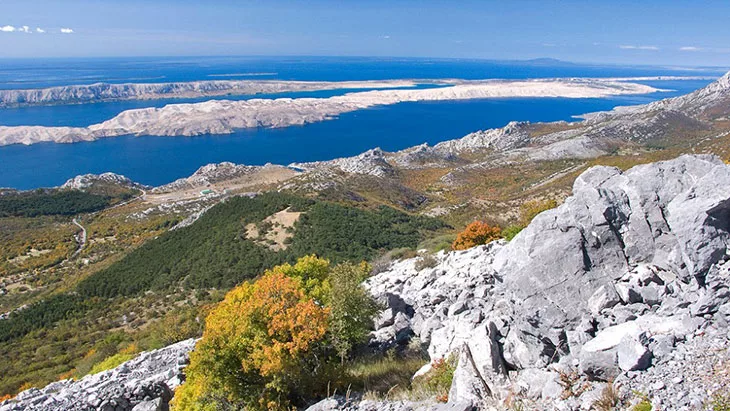
However, if you take the time to get closer, you will discover just how rich this place is not just in vegetation but also in wildlife and in fun outdoor adventure opportunities.
Those who get a chance to inspect this park closer discover the staggering diversity of landscape throughout the deep folds of the mountain.
The Northern Velebit National Park is home to bears, wolves, and lynx but you will spot many other animals including insects and birds of different types.
Toward the center of the park is the smoothly centered peak of Veliki Zavižan.
In it, you will find a meteorological station that also functions as a mountain hut or lodge for climbers all throughout the year.
However, beyond the hut, you will no longer find many tourist facilities so if you will hike this peak, just be prepared to have your own supplies including flashlights if you’re hiking toward the evening.
Even locals from other cities turn to the Northern Velebit mountains and make it their hideaway place when they want some time to disappear from the world.
It is a great escape for the weary and those who are just tired of their boring daily lives.
But even if you have quite an eventful life, it doesn’t hurt to change the scenery once in a while and the Northern Velebit National Park is one heck of a scenery that could be life-changing.
The best way to get to the park is through the steep roads of Sveti Juraj.
It is quite an uphill drive but one that is worth every ounce of gas. The villages in the area are not as fancy as some that you may find near other national parks in Croatia.
The terrain is also somewhat desolate but despite these, there is always something to surprise you within and around the park.
The heart stopping panorama of the Adriatic coast that you will see from the peaks is just one of these surprises.
You may also get a glimpse of the Krk island and Losinj.

The park offers many of the usual activities similar to the other parks like walking, hiking, and biking.
The most popular hiking trail in the Northern Velebit National Park is the Premuzic Trail which starts form the meteorological station.
Some consider it to be the most dramatic hiking path in the Adriatic.
There is also the Rossijeva koliba trail which is a suitable spot for an overnight stop.
Northern Velebit National Park is alive with many animals both the tamer ones and the wild.
Depending on the season and your luck, you can sometimes see groups of sheep huddled in the wall enclosures.
Other times, they are more difficult to spot because other animals also roam around the park like the wolves and bears.
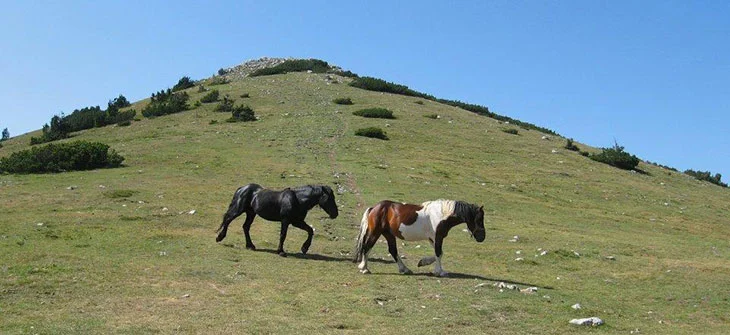
Practically the whole of the mountain is the nature park.
It is protected and hikers can only go through the park’s numerous marked trails.
Its altitude is about 518m to 1,676m above sea level and it covers an area of about 109 square kilometers.
The park is a piece of nature that has been preserved with utmost authenticity.
Till today, what you will see in these parts are its natural landscape shape and all the living things that have survived with it through the ages even though it’s a recently opened national park.
Some mountaineers call this range the most beautiful mountain in Croatia.
Plant and animal life are diverse and exceptionally beautiful.
You should also take some time to stop by the botanical garden inside Northern Velebit National Park.
You can take hiking tours and join excursions, just consider that it’s best to spend the whole day in the park to make the most of your visit.
The park actually within the Velebit Nature Reserve which also covers the area of the Paklenica National Park and this entire area is protected and is considered as a sanctuary.
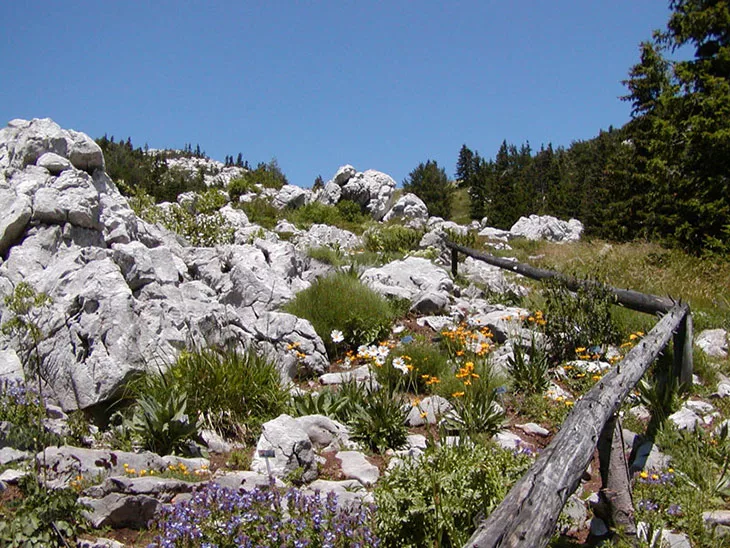
Northern Velebit National Park is not as famous as the other 7 national parks and it does not get as much visitors as Plitvice or Krka.
That may be a good thing because you will be able to enjoy nature without the crowd and just really be one with it for just a few hours.
But since it has been awarded and named as an EDEN – or a European Destination of Excellence, people have grown more interested in it and more and more foreigners and local visitors are starting to give it the attention that it deserves.
This award aims to promote sustainable tourism which is a great way to share Croatia’s natural beauty without destroying it.
Exploring the Northern Velebit Natioanal Park
So, what is inside these tall rock peaks and thick forested lands?
If you haven’t initially thought of visiting the Northern Velebit National Park as part of your Croatian trip, it is most likely that after looking at these details, you may well change your mind.
Rožanski peak and the Hajdučki kukovi
The two main peaks in this mountain range are the Rozanski peak and the Hajdučki kukovi peak where you will find the breathtaking Lukina jama.
Rožanski kukovi
The Rožanski Kukoviis a massive wall of white limestone.
This rocky area is so special because of natural geological forces that have formed the karst around it.
It’s a collection of wild cliffs, towers, and teethed heads of magnificent grayish white!
The peaks are separated by deep holes and chasms and are lined with razor sharp ridges that provide natural passageways to beautiful worlds unknown.
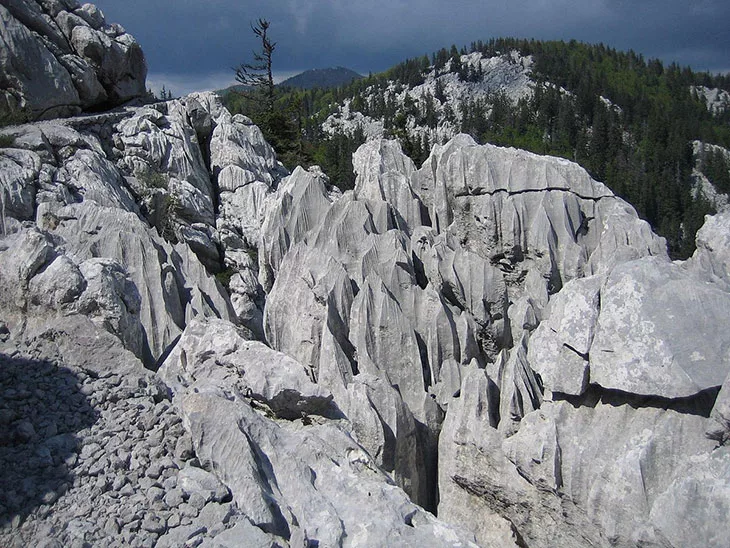
It is a perfectly chaotic mess that came together to form this beautiful wonder of nature.
The land is decorated by beech trees and fir along with the iconic dwarf pines that sprout up from the most unexpected places in the mountain.
The Rozanski kukovi peak takes its name from the Croatian word for hip which is “kuk”.
This is because of the steep rocks that make up the mountain that look like hips. There are at least 40 “hips” or peaks around the area that go up to 1,600m.
Hajdučki kuk
The Hajdučki kukovi peak, on the other hand, is described to be a beautiful route through a very wild nature.
Trails in this peak lead to wild and some unknown parts of the Velebit so it’s important that you take caution when trekking these parts.
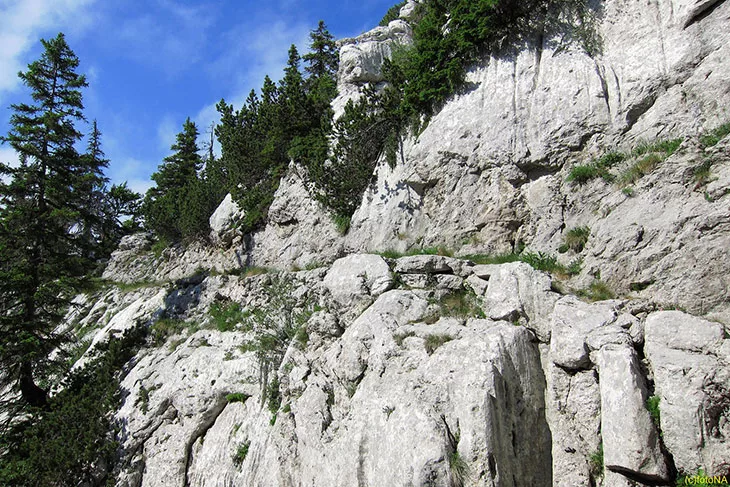
Zavižan
After some time of climbing toward the Vosak side of the mountain, hikers can take some rest and find shade inside the Zavižan meteorological station which also serves as a mountain hut or lodge.
It is open all throughout the year even though it is in an area that is known for extreme weather reports.
During the colder months, the Zavižan hut often posts the lowest temperatures.
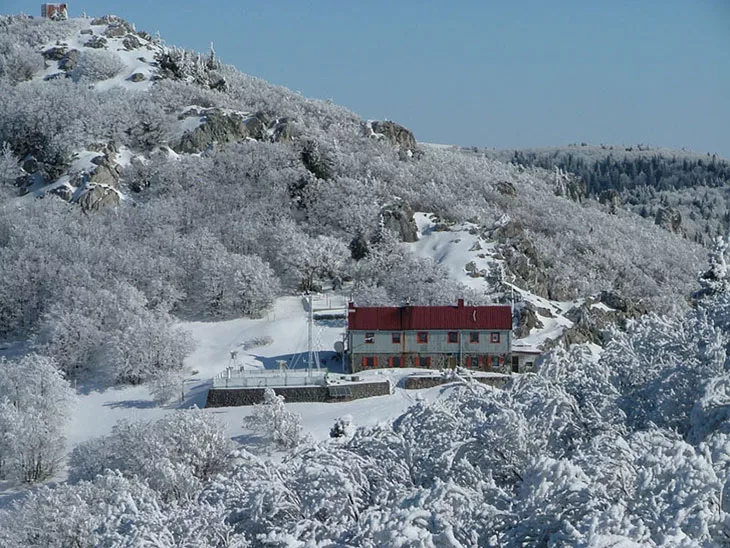
A man named Ante Vukusic has been managing the hut for over thirty years and is the person you can rely on to get accurate hiking advice in these parts of the park.
He is a meteorologist and has excellent insight about the weather.
He may just ask you if you’ve seen horses downhill and that will tell him enough about whether the weather will be pleasant or not.
The meteorological station is the most preferred starting point for hikers who walk through the Premužic Trail.
It’s a stone-paved path that provides hikers a stunning view of the mountain range.
Weather Station – Zavižan
The reason for these extreme weather reports and why meteorologists such as Ante Vukušić of the Zavižan mountain hut are very important is because the way that the weather changes in this range can be crazy!
Sometimes, the weather can change so fast and is proverbial.
In a perfectly sunny day, you can be caught off-guard by rain bearing clouds that are speeding out of nowhere.
During winter, heavy snowfalls may also make it difficult for hikers to access the peak so it is very important to listen to the weather report.
Most of all, the Velebit range is known for the bura which brings mountain winds to a whole different level.
This kind of fierce wind blows a sweeping gust of air from the inland to the sea and is strongest during the cold season.
But beware because the bura can blow up even during the summer and in fact, almost any time of the year.
Hiking In Northern Velebit Croatia
Most hikers prefer to start their excursions at the Zavižan meteorological hut toward the northern end of the park.
It is also a smart idea because there, you can get a reliable weather report as well as hiking advice.
From here, they take the most popular trail, the Premužic Trail.
Let this guide also provide you a good reminder that beginner hikers should travel with a group.
Though it is not the steepest in Croatia, hiking along these parts can be challenging especially because of the complicated weather conditions.
You will see boards and signages in the walking paths that will inform you of the difficulty of the trails as well as the approximate time it takes to hike on those trails.
Premužić Trail
The Premužić Trail runs through the most scenic hiking itinerary as described by those who have hiked in this range.
It is also the most interesting part of the park.
Walking along this route, you can access any of the numerous peaks in the mountain and from there, get a spectacular view of the Adriatic Sea and the surrounding islands.
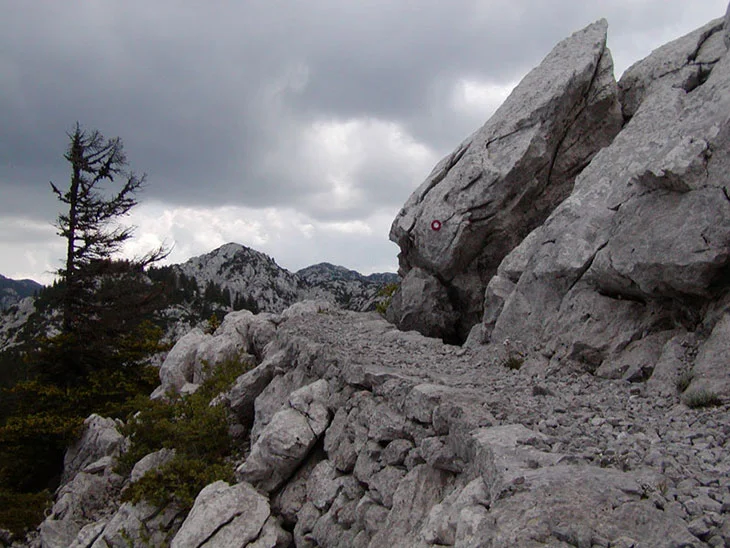
This path is about 57 kilometers long and is great for beginners because there are almost no steep sections.
Most of it is enclosed inside the Northern Velebit National Park Croatia and the rest goes out to the nature reserve.
Rossi’s Hut
Aside from the meteorological station that serves as a mountain hut or mountaineers lodge, there is another hut down south called the Rossijeva koliba which means Rossi’s Hut.
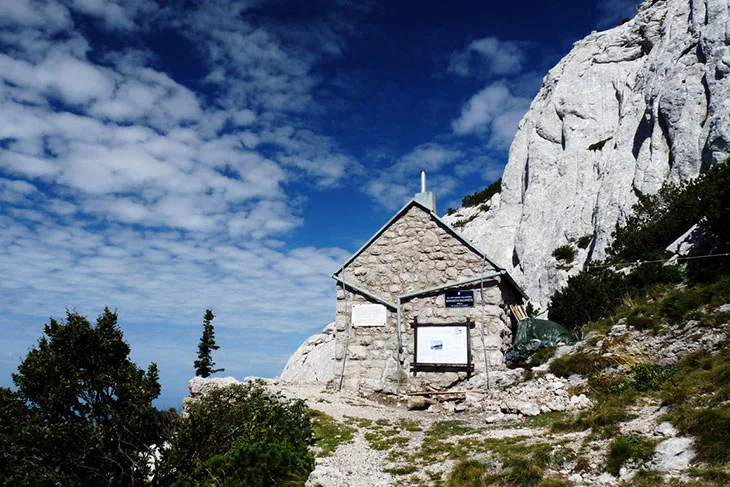
Unlike the former, the Rossi’s hut is unmanned so there is no meteorologist that will give you advice about your hiking trails.
It is about 2 to 3 hours away by foot from the other hut and despite being deserted, it is still a good place to rest and take shade.
What’s special about walking to this hut is the trek itself.
As you walk along the path going to the hut, the scenery changes with almost every twist and turn.
You will pass by beech groves and that soon turn into boulder scapes and back again until you get to the ultimate view of the sea.
Once you get to the hut, you can spend the night if you want to get more of the Velebit range.
But take note that this is not a commercialized area so don’t expect to see stores around and bring your own supplies of sufficient amount.
The structure is quite simple.
It is an ordinary stone shelter and the door is always unlocked.
Though it’s not really unsafe, still be aware of your surroundings if you stay in this hut. Inside, you can use a simple traditional stove to cook a warm meal and sleep on the platform if there is space which there usually is.
It is just along the park’s second highest peak, the Veliki Alan.
Krasno Village
Those who trek from Northern Velebit National Park toward the direction of Zagreb and Split can find themselves going through Krasno village and the Kuterevo bear sanctuary.
It is just one of the few small communities settled at the foothills.
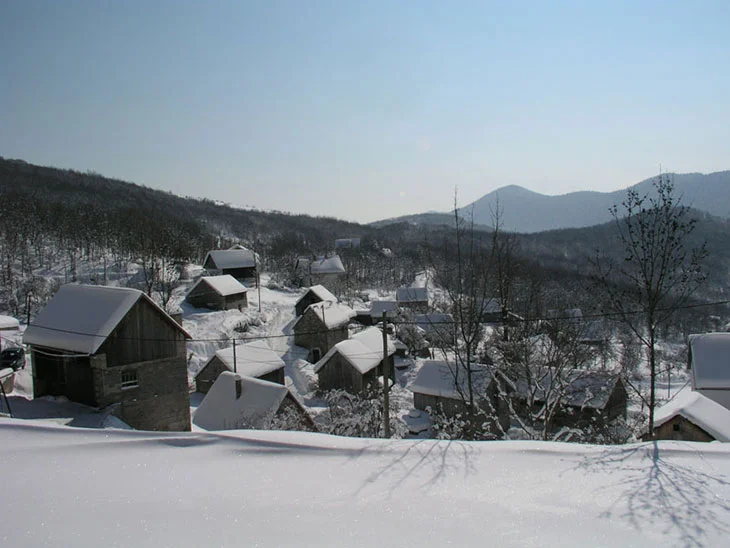
In this town, you can smell strong scents of freshly sawn tree trunks since the village is a center for local logging.
Exploring the village of Krasno is a great way to learn about the history of the timber trade not only in Croatia but in the world in general.
In this town, you will find Krasno’s Forestry Museum where you can get all the information that you want about the history of forest logging.
The museum will provide you good insights of how people who worked in that industry have spent back-breaking hours when technology was not yet as advanced.
You will also see some active logging activities.
Wildlife In National Park Northern Velebit
Northern Velebit National Park is home to many animals including the tamer and the wilder ones.
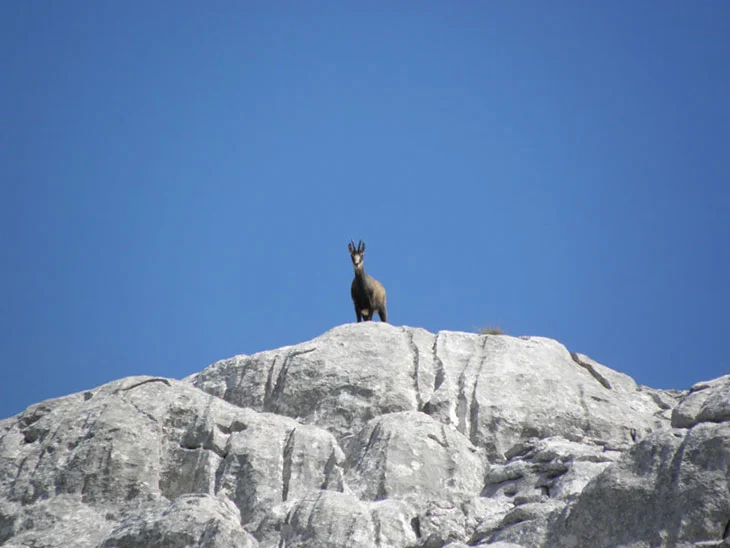
Inside the dry stone wall enclosures, you will often find flocks of sheep huddled together.
This sight gives you a glimpse of the region’s main source of income.
In the Northern Velebit area, you will find some of the region’s most delicious cheese, piquant sheep cheese.
Take some home with you so you have a little bit of the lesser known parts of Croatia to munch on when you’re back to your normal life.
You can get the cheese on Krasno’s main street at the dairy, which has an overwhelmingly friendly staff.
The dairy is called the Runolist and their cheese has become quite popular since the park was declared a national park.
Some visitors do not get the same luck as others and are not able to see the sheep during their visit.
The sheep’s visibility depends on many factors such as the weather and the season.
But oftentimes, they are just trying to keep themselves safe from other wild creatures since the park is also home to wolves and bears.
There are about 400 estimated brown bears inside Northern Velebit National Park but you don’t always spot them out and about because they are spread wide.
But if you really want to observe the bears, you can head to the bear sanctuary in Kuterevo village where you will have a chance to really see them up close.
Other animals that you can observe in the park if you’re lucky include wild cats, red deer and roe deer as well as several species of eagles.
There is also the typical Ural owl as well as the chamois.
Kuturevo Bear Sanctuary
Kutarevo bear sanctuary mentioned above is just in the surrounding area of Northern Velebit National Park.
It is home to several orphaned bears, many of which were abandoned and are too young to take care of themselves.
The sanctuary in Kutarevo is enclosed within fences but the older bears are free to roam toward the rear end.
This is a great thing so that the bears still enjoy their freedom while the park authorities are doing their best efforts to protect them and preserve them.
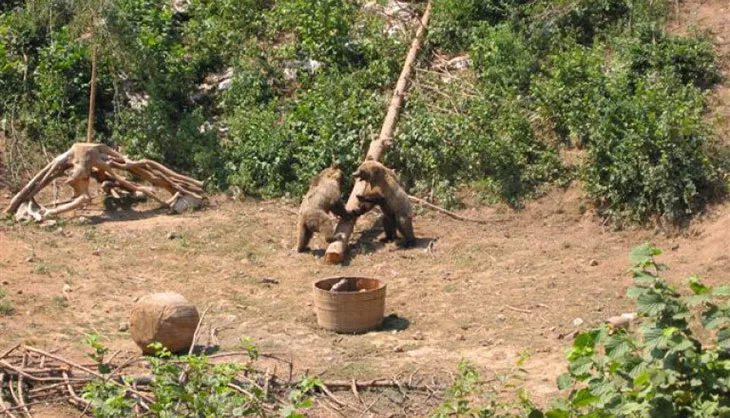
Some people may criticize the sanctuary for taking in young bears since it means that they will grow up not learning the survivals skills that they would have naturally learned in the wild.
However, most people don’t understand how wildlife conservation works and sometimes, it is better to take the young ones into custody to give them better chances of survival.
The bear sanctuary near Northern Velebit National Park fulfills an important role in raising public awareness of several environmental issues, not just of bears.
Watching the bears in the Kuterevo bear sanctuary is like swimming with dolphins. Many would say it is quite a meditative experience.
Flora of Velebit
The Velebit mountain range is not very high but it does have a real mountain climate.
Because of these, plants such as edelweiss and mountain pine, which are usually found in high altitudes, thrive in its peaks.
Botanical Garden North Velebit
To make your outdoor adventures in the Northern Velebit National Park even more thrilling, take some time to stop by the botanical garden near Zavizan.
It displays most of the park’s endemic flora and features about 500 plant species.
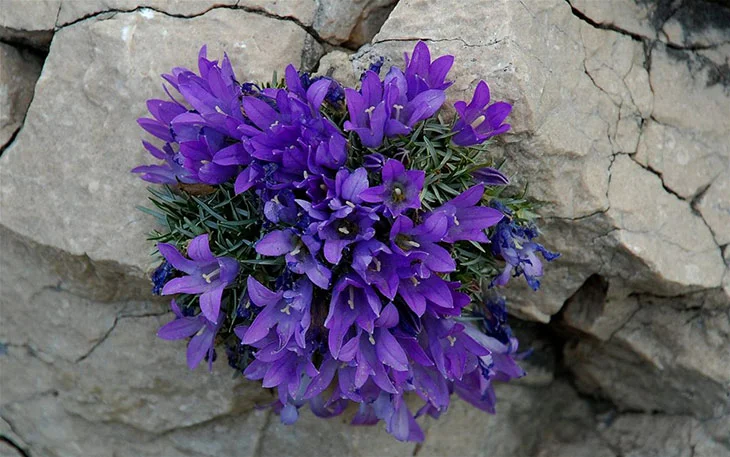
The garden is one of the popular destinations for hikers who start from the meteorological hut paths.
It is about 1,480 meters above sea level and is truly a unique and thrilling experience.
It is a short 15-minute walk away from the mountain hut.
Dr. Fran Kušan who was a professor at Zagreb initialized the establishment of the botanical garden in National Park Northern Velebit.
The garden aims to make the Velebit region’s wealth of plant life accessible to the people who take interest in learning about them.
That makes it available not only to scientists but also to passionate mountaineers and ordinary nature lovers who don’t really know much about the academic side of things.
It was immediately proclaimed as a special botanical reserve shortly after it was established in 1967.
At the center of the botanical garden in Northern Velebit National Park, you will see the sink hole called Balinovac Ponikva.
The area is surrounded by a circular path decorated with stones. It’s also a great spot to start climbing the mountain trails leading to the popular peaks.
Some rare species of plants that you will find in the botanical garden inside the Northern Velebit National Park include the Velebit degennia, Croatian sibirea, and the Velebit pink, among many others.
You will see the names of the plants on illustrated plates along with educational boards that provide information about the natural values of the garden.
It takes at least an hour to complete a tour of the garden but some people stay much longer to enjoy the sight of the beautiful flowers.
It’s best to visit the garden between June and July because most of the plants are in full bloom.
Inside the botanical garden, visitors can take a seat in the rest area where benches are provided.
Scientific works are continuously being conducted in the botanical garden in Northern Velebit National Park.
Lukina Jama
Northern Velebit National Park is also a great spot to explore amazing caves. The mountain range has several deep caves, some with the largest subterranean drops in the world.
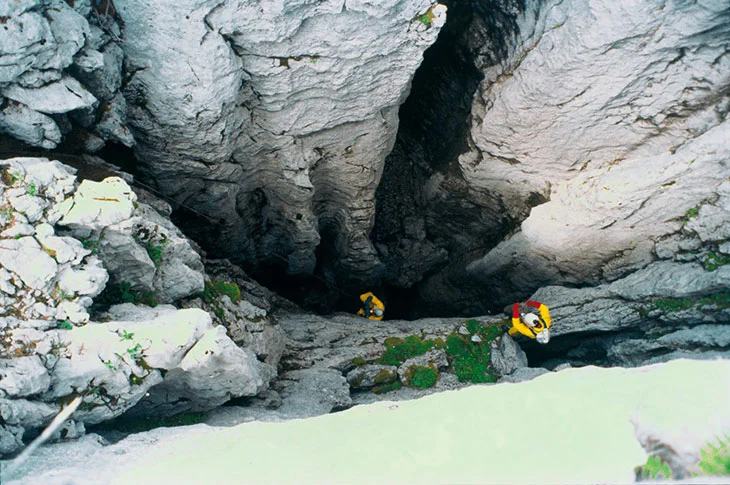
The Lukina jama cave is the deepest in Croatia and the 14th deepest in the world.
If you go down this cave, you will find ponds and streams at its foot but beware of the large subterranean leeches.
You need a guide in order to enter the cave and entrance is not included in the park’s entrance fee.
The cave is about 1,431 m deep and is also the deepest in southeast Europe.
The main passage descends through several minor pitches until it reaches the connection with the upstream passage.
There are two smaller pitches just before you reach the bottom of the cave.
It is truly a unique and breathtaking experience.
This activity is not suitable for kids so if you want to experience going down the cave when you visit Northern Velebit National Park, you may want to have someone in your group or family watch them.
Other notable caves inside the Northern Velebit National Park are the Slovačka jama, the Velebita, and the Meduza.
Getting to Northern Velebit
The Northern Velebit National Park can easily be reached from Otočac if you are coming from Zagreb or Split.
You should use the Zagreb-Split highway or the old road in the Kapela mountain.
When you exit out of the highway, simply head to Krasno where the entrance to the park is.
You can also reach the Northern Velebit National Park via the asphalt road to Stirovaca toward the southeast area of the park.
The best way to get to the park is by car. It is not as easy to reach compared to the other national parks but it is still worth the drive.
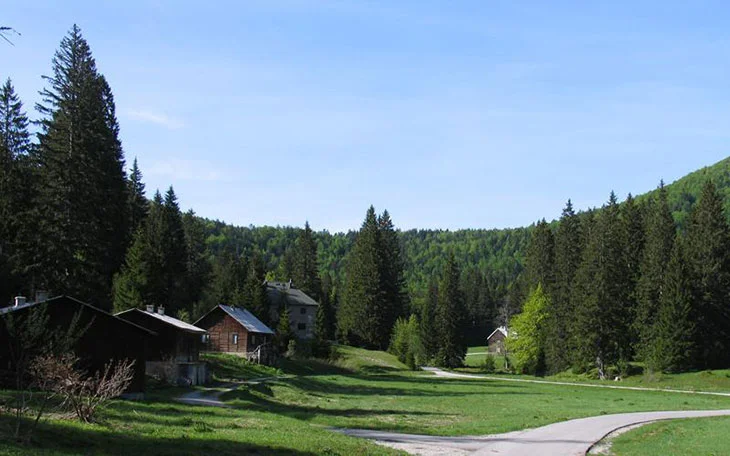
By Bus
You can also get to the Northern Velebit National Park by public transportation or bus. There are no direct buses to the park but you can get off at the nearest drop off.
Take the bus from any major city to the city of Senj.
Buses going there are available from Zagreb, Rijeka, Split, Zadar, and Dubrovnik.
If you are coming from Zagreb, the bus ride is about 2 and a half hours to 3 hours, same as from Zadar.
It is an hour and 30 minute bus ride coming from Rijeka.
Travel by bus from Split going to Senj takes much longer, about 6 to 6 and a half hours.
From Senj, you can reach the Northern Velebit National Park by taking a local bus to either Krasno or Oltari.
If you want to save time, though and really dedicate the hours that you have to seeing the park, it is most advisable to use or rent a car.
Entrance Fees To Northern Velebit Croatia
Entrance tickets to Northern Velebit National Park would depend on the duration of your stay.
There are also discounts for a whole year access to the park.
An individual visit ticket for all guests costs 7 euros and is good for 1 to 3 days.
Staying in the park for 4 to 7 days would cost 8 euro and a whole year access pass is only 50 euro.
If you visit the park with a group, you get a discounted rate of 3 euro per person instead of the regular rate of 5 euro.
Your group can also join the guided tours or programs which are paid individually.
A half-day guided tour costs 70 euro for a group of up to 50 people. Whole-day guided tours cost 130 euro.
If you want your guided tour to include a multimedia presentation, the additional fee to the total package is 35 euros for a group of up to 100 people.
Mountaineers who are part of official mountaineering organizations can also get discounts by presenting their mountaineers’ ID card.
Same discounts and rules apply to citizen pensioners as well as senior citizens. Children aged 7 years and below are always free to enter.
Best Time to Visit Northern Velebit Croatia
The best time to visit the Northern Velebit National Park is from May to October.
These are the best time to really enjoy the mountain range’s authentic beauty.
You will see the most magnificent views in the Adriatic Sea provided by the mountain region’s numerous peaks.
However, the thing that sets Northern Velebit National Park apart from the other national parks is that it is also a great park to visit during the winter.
It is the one park that you can enjoy, aside from the skiing spot in one of the other 8 parks, even in the cold winter days because you will see the mountains transform into giant white-tipped chocolate kisses.

Take note that the only food store in the entire area is in Krasno village so you may want to prepare and bring your own meals especially bottles of fresh drinking water.
This is true throughout the year so be prepared before your hike at the Northern Velebit Croatia.
Check Other Croatia National Parks
- Travel Guide For Krka Waterfalls
- Best Things To Do In Mljet National Park
- Paklenica National Park: Climbing paradise in Croatia
- Top Things To Do In Risnjak Croatia
- Croatia Island Hopping In Kornati National Park
- Top Things To Do In Brijuni Islands National Park
- National Park Plitvice Lakes Croatia
